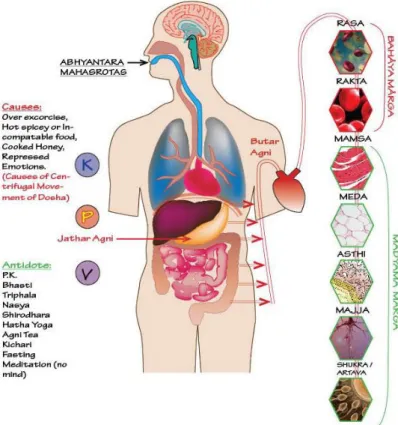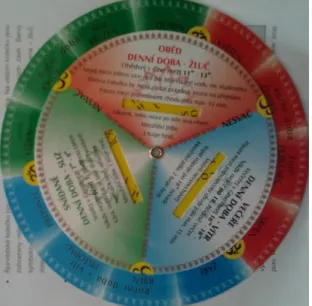Based on a case of chosen, so-called non-conventional medicine within the context of the Czech Republic between 2013 and 2017, I explore how a specific body practice such as Ayurveda functions in this environment. A full description of the theories that most influenced my thinking about the body is then presented to build a solid background for the analysis of Ayurveda as a discourse on well-being1, as an everyday practice of knowing and being different, and as a way to face. different possibilities to live well as an alternative to modernism.
General Theoretical-Methodological Approach: Working with Sociological Theories
There is no very limited discourse about the body presented in (of course despite the small differences between them and in their dynamics) Ayurvedic medical textbooks, laws, established clinical practice, etc., at least not in the environment under scrutiny - an essential part of the Ayurvedic social environment in the Czech Republic during 2013 and 2017. The result of this situation is the establishment of Ayurveda, which occurs through the simultaneous processes of establishing an Ayurvedic body discourse and knowing and experiencing the Ayurvedic body.
Ayurveda
Ayurveda as a Medicine
11 Caraka and Susruta are the names of the authors of the two oldest written accounts of Ayurveda. It can then be argued that "Ayurveda is not a medicine in the sense prevalent in modern Western culture.
A Quick Dip into Today’s Political Context of Ayurveda
36 Křížová (2015) provides an overview of the history of non-conventional medicine in the Czech/Czechoslovak Republic over the past decades. Ayurveda's initial entry into the European healthcare market in the form of Maharishi Ayur-Ved (MAV), popularized by the Indian guru Maharishi Mahesh Yogi (Jeannotat, 2008), therefore had no impact on the Czech healthcare landscape.
Traditional, Alternative or Complementary?
The rest of the publications fall under Indological accounts, such as Miltner's work dedicated to "healing in ancient India" (Miltner 2003). The term "traditional" is outside these four, as it reveals no relation to a dominant medicine, but refers precisely to "the sum of total knowledge, skills, and practices based on theories, beliefs, and experiences native to various cultures (WHO.
Anthropological/Sociological Account of Ayurveda and T&CM
The result of this process is what Pattathu describes as the reconstitution of the patient's identity according to the major Ayurvedic cosmological doshas (tools) (ibid. 157). It requires the experience of changing the self and the body in relation to the "metaphors, technologies and social relations that they encounter" (ibid., 267).
Body: The Story of How I Came to Think of It
- Mary Douglas and the Individual and Social Body
- Pierre Bourdieu and the Practiced Body
- Michel Foucault and Self-government
- Judith Butler and the Performed and Experienced Body
- Ingold, ANT, Ontology Politics and Becoming
- Epilogue to the Body Theory
If it has been possible to constitute a knowledge of the body” (ibid., 59), it was based on power over the body. According to him, it "starts in the body and through reflexive thinking ends in the objects" (ibid., 137).
Methodological reflections
Entrance: Initial Positioning of Myself, the Field and Academia
Yet the results of my initial negotiations upon entering the field not only predetermined the character of the research in terms of field and topic, which goes hand in hand with methodology, but also the associated ethical issues. The researcher leaves traces on the place, on people's lives and sometimes on institutions or even on the way in which the researched phenomenon is transmitted, as in my case.
Accommodation: The Dynamics of Field, Sample and Methods
Changing Position, Field-site, and Topic: Protection and Reciprocity
This allowed me to organically follow most of the key informants from the beginning of their Ayurvedic studies. 60 Since I had already completed two years of Ayurvedic studies in the first school, I did not face the same dilemmas with the gatekeeper of the second school as I did with the teacher.
Representation and Objectivity Grounded in the Body
Regarding participant observation, however, I have chosen non-resistant consent in order not to undermine the established relationships between myself and the informants in the early stages of the research (ibid.). The theoretical overlap, reflexive treatment of the research process and the visibility of the researcher in the text is what an autoethnography shares with today's treatment of ethnography in anthropology. They were, as I believe, aimed at ethics in relation to the validity of my arguments, i.e.
Reviving objectivity requires acknowledging the embodied nature of the researcher's position in the field and knowledge itself.
How Alternative Should You (Not) Be to Study Nonconventional Medicine?
One of the strongest arguments in favor of Ayurveda is that it is a real science (meaning the same science as biomedicine). We are sitting in the garden of the Teacher's house in front of a large approx. With the discovery of the body (Baarts and Pedersen, 2009) there is therefore also a transformation of its form.
Thus, recognition of the body's interconnectedness also causes an increase in the agency of all interconnected things.
The Character of Ayurveda: Construction of Ayurvedic Discourse within School
Ayurveda as a Wisdom and Way of Well-Being
This interfered with the self-healing ability of the human body and people began to get sick. This idea is based on the understanding that all entities of the world are made up of the same five elements (ether, air, water, earth, fire) - panchmahabhoot71 in Sanskrit. Character is meant here in the broadest sense of the word, as properties of body and mind—.
In Ayurveda schools, students learn that all things in the world are made up of different proportions of the above elements (ether, air, fire, earth and water).

Ayurveda as a Relevant Framework for Life
The teacher shows a picture of Václav Havel and comments on it: “A Rishi73 who is devoted to the education of the nation. I am not talking here about the school's business strategies, but about the ways in which it fits into the local environment through the everyday lives of local people. In addition to explaining how life (the body) works according to Ayurveda and how, according to this logic, well-being can be achieved by reducing individual suffering (mainly physical), the Ayurvedic way of life is modeled in the school.
The Ayurvedic approach is often explained in relation to biomedicine, especially local aspects of clinical practice that are considered too reductionist by most in the school.

Enacting Ayurveda Discourse within the School Space
Its legitimacy is constructed by demarcating Ayurveda against the reductionist methods of Western medicine; commodification of the body, health and leisure time;. At the same time, it is legitimized by the rhetoric of its attitude towards the Orientalist depicted India, where traditional values of family and religion and social hierarchy still play a role and where people naturally coexist with the surrounding natural environment. The reference to a more natural, other "exotic" East is then offset by several continuities, both in the form of correlativeness (Lin and Law 2014) between Ayurveda and some aspects of Western medicine and its thematization as something familiar that we have, in the flood of information and the speed of modern lives forgotten.
Thus, on the ground, Ayurveda is defined against widely identified causes of discomfort, as well as against aspects of Western medicine that are inaccessible to the lay person and constructed as a hypothetical, simple and natural comprehensible way of life.
The Politics of Two Ayurveda Schools
- Pavol’s Approach
- Teacher’s Approach
- The Two Approaches in Students’ Practice
- Politics of Ayurveda Promotion and the Individual Practice
On the other hand, Jakub is a supporter of the school in which I started my research. The goal of the practitioner of this medicine can also be wisdom, but in the sense of expertise. I interpret the Teacher's intention to be the rehabilitation of traditional Ayurveda within the space of the Czech Republic.
In this second empirical part of the thesis, I focus on the main findings regarding individual Ayurvedic practice.

Learning to Know, to Function and to Value Differently
Learning Ayurveda: Knowing Differently through One’s Own Body
In Ayurvedic practice, a connection is established between the external and internal parts of the body. Thus, in practice, there is a discovery of the body and its constitution as a coherent whole. Awareness of the interconnectedness of the body enables and thus causes a transformation in the treatment of the body.
In the process of making Ayurvedic bodies, there is a transformation of the perception, experience and reproduction of the body and the environment.

Learning Ayurveda as Bodily Practice: Regime and Morality
Ayurvedic Practice as a Specific Body Becoming
My shelf of Ayurvedic remedies, including sesame oil for internal and external body lubrication. I put it in my porridge - that should reduce the heaviness of the milk and fruit and help with digestion. It also reflects some of the most common thoughts and questions that participants experienced during the survey.
In addition to emphasizing the interconnectedness of the body's organs, it thematizes the individual's dependence on the environment.
Becoming Bodies Differently
- Inside and Outside of the Body
- Body and Mind
- The Body-Mind System, Other Entities and the Environment
- Interconnection: Awareness, Recognition and Articulation
- Im/possibility of Self-control and Self-mastering
- The Main Tenets and Limits of Becoming Bodies through Ayurveda
Bruno Latour also disputes reflections on the body (though not in the context of CAM). However, this is not an awareness of the body, but of its internal interrelationship and interrelationship with the external environment. Similarly, food, once passive (although it may have caused feelings of overeating), is now more connected to the body.
The exterior and interior of the body, the mind, the food the body interacts with.
Well-being Troubles: Ayurveda and Other Games
- Normalization and De/medicalization of an Individual
- Im/possibility of Treatment
- Im/possibility to Maintain Social and Intimate Relations
- Im/possibilities of Having a Job
- The Limits of Ayurvedic Practice
It went smoothly." The Teacher explained to him that the more he eats, the more often the pancreas injects insulin into his body. Nevertheless, Whyte also argues that "the pressing concern for most people is not problems of interpretation or existential issues of ontological certainty" (ibid.), they are often uncertain about pragmatic existential issues, such as fear of not having enough money not to survive (ibid.). .). We make a mistake that we still don't get.. the naturalness of the individual.
You kind of do everything quickly, superficially, just to make it happen because that's the requirement, but you don't look too much at quality anymore, and you don't look too much at rest either."

Responsibility and Ayurveda as an Example of Alternative
- Imagining Ecosystem as a Natural Way of Being
- Ayurvedic Discourse as Alternative
- Unblackboxing Ecosystem in Practice
- Ayurveda and the Limits of Alternatives
The ecosystem really works to be fine in the phase when it is stable – the peak phase. It is manifested in the popularity of the New Age phenomenon (Heelas and Woodhead 2005), the so-called (spiritual) quest (cf. Warrier 2008) and the rise of unconventional medicine and healing practices (Siahpush 1998; Coulter and Willis 2004). While the body in modernity is institutionalized from the outside – by establishing the professional domain of human science and thus practiced through its use in the form of clinical biomedicine – in Ayurveda it is institutionalized from the inside: through the practice of cognition. the body.
Ontology of Personality in Ayurveda from the Perspective of Patients and Physicians' in Palampur, Himachal Pradesh: An Independent Study'.





